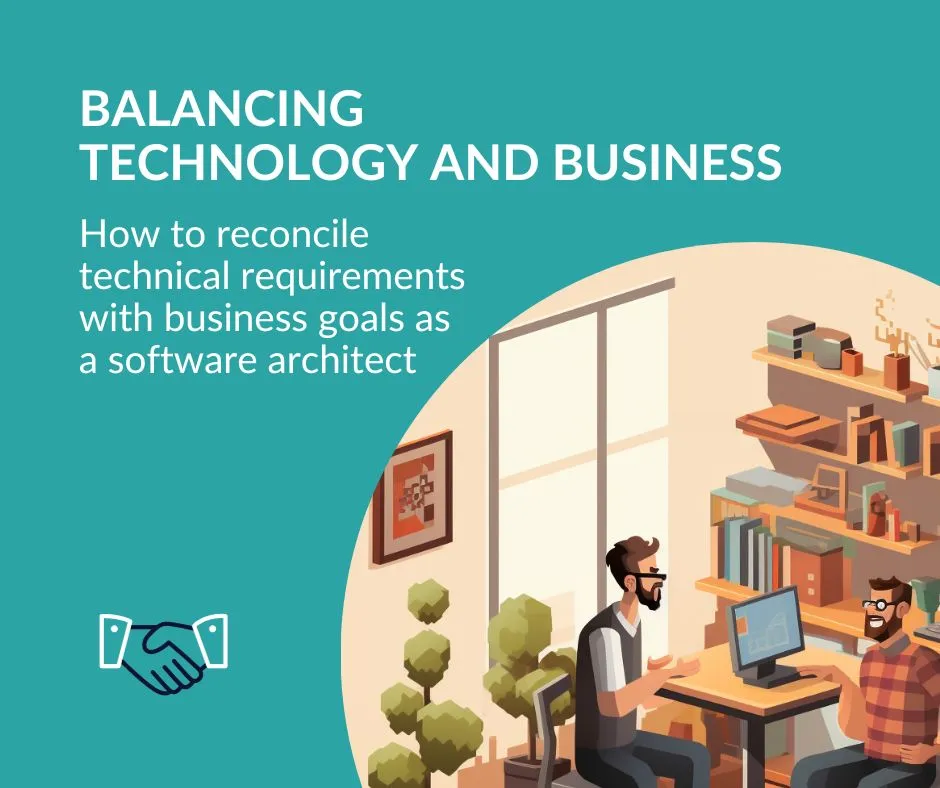
In today’s fast-paced digital landscape, software architects play a vital role in navigating the complexities of technology and business. But what happens when these two worlds collide, and how do software architects reconcile their technical expertise with the ever-evolving needs of businesses?
In this blog post, we’ll explore the intricacies of balancing technology and business, shedding light on the challenges and opportunities software architects face as they strive to create harmony between these two essential domains.
By delving into the role of software architects, their evolving responsibilities and strategies. We’ll uncover the keys to success in this delicate balancing act. So, let’s embark on this journey of discovery and learn how to transform how we approach technology and business integration.
Pulse points
-
Software architects must combine technical and business knowledge to balance technology and business successfully.
-
Software architects play a critical role in IT projects, utilizing strategies to ensure that technology meets objectives.
-
Software architects can leverage technology for better outcomes while optimizing customer experience by involving stakeholders from both sides.
Why balancing technical requirements with business goals is crucial for software architects

The world of technology is constantly evolving, with innovations like cloud computing, artificial intelligence, and virtual reality reshaping how businesses operate.
However, the rapid pace of change can also create an information gap, where technical requirements and business objectives become misaligned. As software architects, it’s crucial to bridge this gap and ensure that technology supports and drives business success.
Software architects face numerous challenges in achieving the perfect balance between technology and business, including addressing the implications of technology on business operations, ensuring data security, and analyzing data to make informed decisions.
By harmonizing technical requirements with business objectives, they can guarantee that technology is employed effectively, resulting in cost savings, increased efficiency, and enhanced user experiences.
The significance and role of software architects in large projects today

Software architects have become increasingly significant in managing large-scale IT projects, responsible for designing software systems that meet both technical and business requirements. As technology advances, such as artificial intelligence, continue to reshape the business landscape, aligning technology with business objectives has never been more critical.
Software architects must employ various strategies and practical steps to achieve harmony between technology and business. These include understanding the business objectives, communicating with stakeholders, analyzing and correlating technical requirements with business objectives, and formulating a plan to ensure that technology is utilized to achieve the desired business outcomes, such as improving customer interactions.
Challenges in balancing technology and business

Balancing technology and business is no easy feat, with software architects facing numerous challenges in their quest for the perfect equilibrium.
One such challenge is maintaining an up-to-date technology infrastructure while optimizing the customer experience, often requiring a delicate balance between digital technology and human customer service.
To overcome these challenges, software architects must effectively combine technical and business knowledge, investing in technology training and support to ensure successful integration and adoption of new tech.
By leveraging big data and augmented reality, they can provide valuable insights and interactive experiences that delight customers while maintaining the human touch essential for technological advancement.
The Role of Software Architects

As technology continues to evolve, so does the role of software architects. From designing high-level concepts to overseeing the successful execution of software blueprints, these professionals play a pivotal role in ensuring the harmonious integration of technology and business.
In the following subsections, we’ll explore the many facets of this complex role, examining the benefits of combining technical and business knowledge, the consequences of unresolved conflicts between technology and business, and the strategies software architects employ to bridge the information gap.
In IT projects, software architects are responsible for formulating and executing software system plans, making high-level design decisions, and ensuring that the software fulfills the technical and business needs of the project.
By combining their technical expertise with a deep understanding of the business requirements, software architects can create technically sound solutions that align with the organization’s objectives.
This comprehensive understanding of a project’s technical and business aspects enables software architects to adeptly harmonize the two, resulting in enhanced efficiency, cost savings, and an improved user experience.
Conversely, inadequate consideration of technical or business requirements can lead to project delays, cost overruns, and suboptimal user experiences.
The Crucial Role of Integrating Technical and Business Knowledge
A comprehensive understanding of both technical and business components is crucial for software architects to effectively reconcile them and craft solutions tailored to the organization’s objectives. This dual-communication role makes software architects essential for encouraging mutual comprehension and agreement between business and technology.
By possessing technical proficiency and soft skills such as communication, problem-solving, and conflict resolution, software architects can foster a seamless integration of technology and business. This, in turn, enables them to make informed decisions that are consistent with the organization’s aims and guarantee that the project is successful.
Exploring the Advantages of Successfully Merging Technical and Business Aspects
Effectively combining technical and business knowledge empowers software architects to make well-informed decisions, streamline communication between technical and non-technical stakeholders, and optimize the overall performance of the business. Moreover, it offers a unique perspective that can be advantageous in various roles and industries.
By gaining a comprehensive understanding of both the technical and business aspects of a project, software architects can proactively identify potential issues and create solutions tailored to the business’s needs. This, in turn, contributes to a more efficient business and successful projects.
Balancing Technical Requirements and Business Goals

The human connection, which is a crucial aspect of human interactions, plays an imperative role in harmonizing technology and business, as key performance indicators necessitate an experienced eye to interpret, analyze, and present in a meaningful manner.
In managed IT services, experienced teams can gather data through automation to inform strategic decisions, adjust to fluctuating requirements, and plan ahead more effectively.
Software architects can achieve the right balance between innovative technology and personalized support by leveraging technology that optimizes customer experiences and adds value to existing interactions.
The involvement of real people in digital initiatives can significantly enhance customer experiences and lead to better outcomes. This human touch in the digital realm adds a layer of personalization and empathy that technology alone can’t replicate.
It brings a sense of authenticity and trust, making customers feel valued and understood. By integrating real people into digital initiatives, businesses can foster stronger relationships with their customers, leading to higher customer loyalty and satisfaction.
What is the impact of technology on business?
Technology has significantly impacted how businesses operate, allowing them to become more visible and accessible globally. It has allowed for better communication and efficient internal processes, leading to improved services.
These advancements have enabled businesses to reach new markets, increase their customer base, and expand their operations. They have also enabled businesses to reduce costs and increase profits.
Unpacking the Significance of Aligning Technical Requirements with Business Goals

Balancing technical requirements with business goals is essential for ensuring that technology is not only aligned with the overall objectives of the business, but also contributes to its success.
Software architects can employ various approaches to analyze and align technical requirements with business objectives, such as using a requirements traceability matrix, constructing a business case, and implementing a risk assessment matrix.
Software architects who successfully align technical requirements with business goals can enjoy numerous advantages, including increased efficiency, cost savings, and enhanced user experiences. Conversely, unresolved conflicts between technology and business can result in delays, cost overruns, and decreased customer satisfaction.
Various methods to examine and align technical necessities with business goals.

To effectively align technical requirements with business objectives, software architects must involve stakeholders from both the technical and business sides in the requirements gathering process.
Establishing core values and creating a common language that defines requirements and quantifies need is also essential for ensuring that all stakeholders are aware of the project’s aims and objectives.
By adopting strategies such as data-driven decision-making, creating a shared understanding of the project goals, and utilizing agile methodologies, software architects can successfully align technical requirements with business objectives and guarantee the project’s success.
When unresolved technology-business conflicts can create problems

Conflicts between technology and business can arise in various situations, such as when a company seeks to implement new technology, but the IT department is unable to accommodate it. Other potential conflicts may include discrepancies between company visions, overestimating capabilities, and inadequate communication.
Unresolved conflicts between technology and business can result in delays in project completion, increased costs, and decreased customer satisfaction. Resolving these conflicts is essential to ensure timely completion of projects, cost-efficiency, and customer satisfaction.
Achieving Harmony

Navigating the intersection of technology and business can be a complex and challenging endeavor. However, through careful planning, effective communication, and innovative approaches, software architects can achieve harmony between these two essential domains.
In the following subsections, we’ll explore the strategies and practical steps that software architects can employ to foster this harmonious integration, as well as the role of communication in achieving business goals and successful project examples.
Introducing strategies and practical steps that software architects can take to achieve harmony between technology and business.

To foster harmony between technology and business, software architects should involve business stakeholders in the technology decision-making process, ensuring that technology decisions are aligned with business objectives.
Additionally, aligning IT operations with business objectives can minimize costs, enhance agility, and maximize return on investment.
Furthermore, comprehending business objectives and making technology decisions accordingly is essential to ensure that technology is used to support the business goals and objectives. By adopting these strategies and practical steps, software architects can create a seamless integration between technology and business.
Role of communication with stakeholders and the project team in achieving business goals.
Communication with stakeholders and the project team is essential for attaining business goals, as it ensures everyone is aware of the objectives and what is expected of them.
Effective communication also helps foster trust and positive sentiment towards the project or company, which can contribute to overall success. This is because clear and open communication helps to eliminate misunderstandings and creates a sense of transparency.
By keeping all stakeholders informed about project developments, decisions, and challenges, software architects can ensure everyone is on the same page and working towards the same goals.
Furthermore, effective communication can also encourage feedback and input from team members, leading to innovative ideas and solutions. Ultimately, strong communication is a cornerstone of successful projects, enhancing team collaboration and driving project success.
By having an understanding of both the technical and business aspects of a project, software architects can more effectively communicate with both technical and non-technical stakeholders, resulting in more successful collaboration and improved results. This underscores the importance of communication in achieving harmony between technology and business.

The Benefits of Merging Technology and Business
Projects that successfully aligned technology and business have seen improvements in operational efficiency, business innovation, and faster time to market. Aligning IT with business is critical for gaining a competitive advantage, enabling businesses to leverage technology to gain a competitive edge, optimize operational efficiency, and accelerate innovation.
For example, the development of a mobile app for a retail store enabled many customers to access the store’s products and services conveniently, leading to a boost in sales and customer satisfaction. This example demonstrates the significant advantages that can be gained when technology and business are successfully aligned, including fostering customer loyalty.
Beyond Traditional Roles
As the role of software architects continues to evolve, so too does their influence within the organization. In addition to their traditional roles, software architects are increasingly taking on more strategic functions, closely aligned with decision-making positions in businesses.
In the following subsection, we’ll explore the implications of this shift and how it can benefit both the organization and the software architect.
Traditional Software Architects and Common Anti-Patterns
Software architects play a critical role in designing and implementing software systems. They are responsible for creating the high-level design of the system, ensuring that it meets both technical and business requirements.
However, in their quest to create the perfect architecture, they may inadvertently fall into the trap of common anti-patterns.
Anti-patterns are common solutions that initially appear beneficial but can lead to unanticipated negative consequences. Identifying and understanding these anti-patterns can help software architects avoid potential pitfalls and create more effective software architectures.
Here are a few common anti-patterns that software architects should be aware of:
-
Over-engineering: This happens when architects design a system that is more complex than necessary. While it may seem beneficial to account for every possible future scenario, over-engineering can lead to unnecessary complexity, making the system harder to maintain and understand.
-
Gold plating: This refers to the practice of adding functionality that wasn’t initially requested, with the assumption that it will be beneficial in the future. This can lead to wasted resources and can potentially introduce new bugs into the system.
-
Reinventing the wheel: This occurs when architects unnecessarily create custom solutions for problems that have already been solved. Using existing, well-tested solutions can save time and resources.
-
Proof of Concept Fallacy: This anti-pattern occurs when software architects design systems without preparing a proof of concept. They might create a design that looks perfect on paper, but it may not be feasible for developers to deliver later. This can lead to a lot of wasted time and resources, as developers struggle to implement a design that was not thoroughly vetted. To avoid this, software architects should always create a proof of concept and validate their designs before moving forward.
-
Lack of Communication with Developers & Being the “Smartest One in the Room”: This anti-pattern arises when a software architect isolates themselves from the development team, assuming they have all the answers. This can lead to a disconnect between the architect’s vision and the developers’ practical realities. It’s important to remember that great ideas can come from anywhere, and a successful software architect fosters an environment of open communication and collaboration, rather than positioning themselves as the sole source of wisdom.
By recognizing these anti-patterns, traditional software architects can avoid common pitfalls and create more effective, efficient, and maintainable software systems.
Considering the development of software architects into more strategic functions, closer to decision-making positions in busines

By assuming more strategic roles, software architects can facilitate the synchronization of technical decisions with business objectives, enhance communication between technical and non-technical teams, and boost the organization’s overall performance.
Furthermore, software architects who expand their role to meet the needs of the entire enterprise can bring significant advantages, including increased efficiency, enhanced interdepartmental communication, and better alignment of technology and business objectives.
To move into more strategic functions, software architects should strive to gain an understanding of the needs of both the users and the organization, collaborate with enterprise architects to propose changes or enhancements based on the current architecture, and communicate with stakeholders and the project team to ensure that business goals are met. By doing so, software architects can contribute to the overall success of the organization and drive innovation forward.
The advantages of broadening the role of software architects to cater to entire enterprise needs
As software architects extend their role to meet the needs of the entire enterprise, they can bring numerous benefits to the organization, such as increased efficiency, enhanced interdepartmental communication, and better alignment of technology and business objectives.
In the following subsections, we’ll explore the role and significance of merging technology and business for software architects, as well as the advantages of encouraging readers to subscribe to newsletters for regular updates and tips on this topic.
The role and significance of merging technology and business for software architects
Combining technology and business is essential for software architects as it enables them to construct software solutions that fulfill the requirements of both the users and the organization.
By grasping both the technical and business aspects of a project, architects can work with enterprise architects and propose modifications or enhancements based on the current architecture.
This dual-communication role makes software architects essential for encouraging mutual comprehension and agreement between business and technology.
By possessing technical proficiency and soft skills such as communication, problem-solving, and conflict resolution, software architects can foster a seamless integration of technology and business.
What benefits can be gained from extending the role of software architects to meet the needs of the entire enterprise?
Extending the role of software architects to the entire enterprise can bring numerous benefits, including increased efficiency, improved communication, and better alignment between technology and business objectives.
By taking a holistic approach to software architecture, organizations can ensure that their technology investments are in line with their business goals. This can lead to improved productivity, better customer service, and a more agile organization.
Software architects can also help.
Summary
The role of software architects in today’s technology-driven world is more crucial than ever, as they strive to bridge the gap between technical requirements and business objectives.
Through effective communication, collaboration, and innovative approaches, software architects can successfully navigate the complexities of technology and business integration, ensuring that projects are executed efficiently and provide value to both users and organizations.
As we move forward in the rapidly evolving digital landscape, it’s essential for software architects to continuously refine their skills and adapt to the ever-changing demands of the industry.
By merging technical and business knowledge, embracing strategic functions, and staying informed through newsletters, software architects can not only achieve harmony between technology and business, but also drive innovation and success for their organizations.
Are you looking for software architect?
If you’re in need of a software architect, look no further. As a seasoned freelance software architect, I am ready and eager to bring my skills to your project. My experience spans across various technologies, and I’m confident in my ability to bridge the gap between technical requirements and business objectives.
I understand the intricacies of both technology and business, and I am adept at navigating the complexities of integrating these two domains. My role doesn’t stop at designing high-level concepts and overseeing the execution of software blueprints. I take pride in ensuring the harmonious integration of technology and business, leading to enhanced efficiency, cost savings, and an improved user experience.
Whether you’re embarking on a new project or seeking to optimize an existing one, I’m here to help. I offer a comprehensive understanding of both technical and business aspects of a project, and I’m committed to delivering technically sound solutions that align with your organization’s objectives.
Ready to get started? Use the form below to send me a message. Let’s discuss how we can work together to achieve your business goals.

 Github
Github
 Linkedin
Linkedin